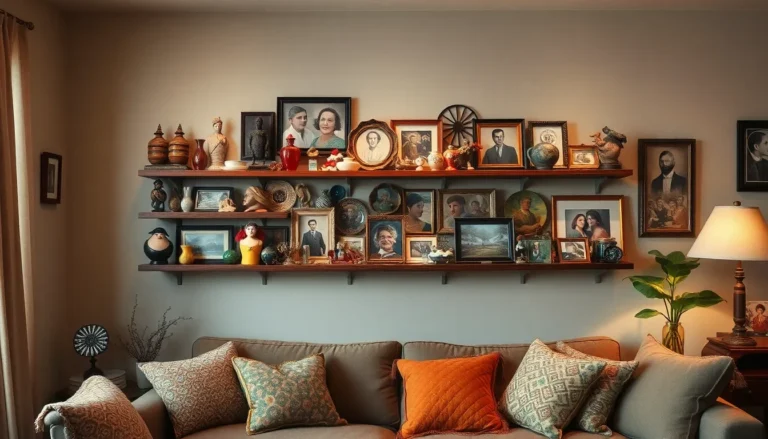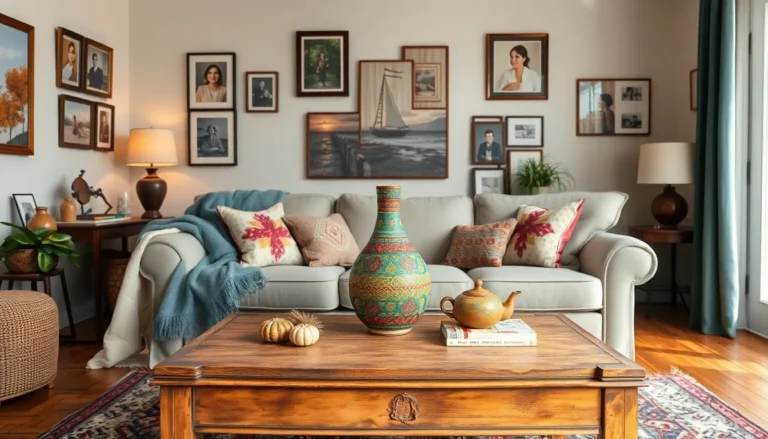In a world where bright lights can feel like a personal attack on the senses, low light comfort emerges as the unsung hero of relaxation. Imagine sinking into a cozy chair with just the right amount of soft glow, where stress melts away like a popsicle on a hot summer day. It’s not just about dimming the lights; it’s about creating an atmosphere that invites tranquility and sparks joy.
Low light comfort isn’t just a trend; it’s a lifestyle choice that even the most hardcore night owls can appreciate. From stylish lamps to mood-enhancing candles, embracing the dark side has never felt so good. So, whether you’re winding down after a long day or hosting a gathering that’s more chill than thrill, discover how the right lighting can transform any space into a sanctuary of comfort.
Table of Contents
ToggleUnderstanding Low Light Comfort
Low light comfort creates an atmosphere of relaxation and peace, serving as an antidote to the harshness of bright lights. This ambiance draws many to embrace a lifestyle centered around softer illumination.
Definition of Low Light Comfort
Low light comfort refers to the use of soft lighting to foster a calming environment. This type of lighting typically involves lamps, dimmable fixtures, or candles that emit warm hues. Achieving this comfort means incorporating elements that reduce glare and enhance personal tranquility. Spaces exhibiting low light comfort often create feelings of safety and well-being. Such atmospheres invite people to unwind after long days, promoting relaxation and mindfulness.
Importance in Lifestyle and Design
Integrating low light comfort into everyday life enhances overall well-being. Many individuals find that softer lighting reduces stress levels while improving mood. Designers recognize the value of this feature in creating inviting interiors, choosing colors and materials that complement soft light. Spaces adorned with low light sources also encourage social interaction, fostering connections among friends and family. In homes, restaurants, and workspaces, designers often prioritize low light comfort to promote relaxation and enhance productivity.
Factors Influencing Low Light Comfort

Various factors contribute to the overall experience of low light comfort, creating an environment that promotes relaxation and tranquility.
Lighting Conditions
Lighting conditions play a crucial role in low light comfort. Dim lighting reduces harsh glare and fosters a calming ambiance, making spaces more inviting. Functional and decorative lighting fixtures, like floor lamps and wall sconces, provide versatile options for achieving soft illumination. Additionally, the strategic placement of light sources can enhance a room’s overall feel. Opting for dimmable lights allows for adjusting brightness levels according to individual preferences, ensuring a tailored experience.
Color Temperature
Color temperature significantly impacts the perception of comfort in low light settings. Warm whites, typically ranging from 2700K to 3000K, create a cozy atmosphere that promotes relaxation. Cooler hues, on the other hand, may induce alertness and detract from a tranquil environment. Selecting the right bulbs enhances mood and aligns with desired feelings within a space. Artfully incorporating warm-toned lighting fosters an inviting area, especially in common gathering spots.
Interior Design Elements
Interior design elements contribute profoundly to low light comfort. The use of soft fabrics and muted colors establishes a serene environment. Incorporating materials like wood, textiles, and natural elements enhances warmth and comfort. Strategically placed mirrors can amplify soft lighting effects, making spaces appear more expansive. Furnishings arranged to promote relaxation, combined with thoughtfully selected colors and textures, create a harmonious atmosphere that encourages unwinding and social interaction.
Benefits of Low Light Comfort
Low light comfort promotes a variety of benefits, enhancing both physical and mental well-being. By creating a soothing ambiance, it significantly improves relaxation and sleep quality.
Enhanced Relaxation
Low light environments help reduce stress levels naturally. Softer lighting, such as from lamps with warm hues, encourages a sense of calm. When individuals enter a dimly lit space, tension often melts away. They find it easier to kick back and unwind in an atmosphere that feels safe and inviting. Soft lighting also invites social interactions, enabling conversations without distractions. Ultimately, the overall comfort level increases, allowing for peaceful moments after a long day.
Better Sleep Quality
Low light comfort enhances sleep by signaling to the body that it’s time to rest. Dimming lights in the evening prepares the mind for relaxation. This gradual transition reduces the likelihood of overstimulation from harsh lighting. It promotes the production of melatonin, a hormone essential for sleep. When bedrooms utilize warm, low lighting, individuals often experience deeper and more restful sleep. They also tend to wake up feeling refreshed and rejuvenated, making it crucial to incorporate low light solutions in nighttime routines.
Strategies to Improve Low Light Comfort
Creating an inviting atmosphere requires intentional strategies. Focus on elements like lighting, color schemes, and textures for optimal low light comfort.
Choosing the Right Lighting
Selecting appropriate lighting fixtures enhances the overall ambiance. Incorporate warm LEDs or incandescent bulbs to create a soothing glow. Dimmable lights allow for adjusting brightness, adapting to different activities. Soft lamps strategically placed near seating areas promote relaxation. Consider utilizing floor lamps or table lamps, as these provide additional layers of light, enhancing comfort.
Utilizing Color Schemes
Color selections play a crucial role in establishing a calming environment. Choose warm, muted colors for walls and furnishings to encourage relaxation. Colors like soft beige, light gray, or pastel shades foster tranquility. Accents in darker shades can create depth without overwhelming the senses. Integrating monochromatic palettes with varied textures enhances visual interest while maintaining serenity.
Incorporating Textures and Fabrics
Textures significantly contribute to a comfortable space. Opt for soft fabrics such as cotton or wool for curtains and upholstery. Layering textiles like throws and cushions invites coziness. Use natural materials, like wood and stone, to create a harmonious balance in design. Incorporating these elements creates a tactile experience enhancing overall low light comfort.
Embracing low light comfort can significantly enhance one’s quality of life. By creating an inviting atmosphere through soft lighting and thoughtful design elements, individuals can foster relaxation and tranquility in their daily routines. This intentional approach to lighting not only reduces stress but also promotes better sleep and social interactions.
As more people recognize the benefits of low light environments, integrating these principles into home and workspace designs becomes essential. Whether through stylish lamps or warm candles, the right lighting transforms any space into a comforting retreat. Prioritizing low light comfort is a simple yet effective way to improve overall well-being and cultivate a serene lifestyle.



